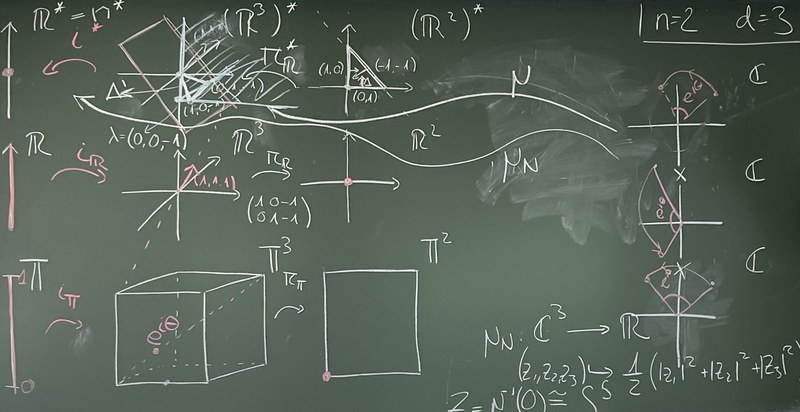Geometric structures that model dissipative dynamics, integrable systems and geometric quantization
Jan 18, 2024
Pau Mir Garcia defended his thesis co-supervised by Eva Miranda on January 16 at the FME. Entitled "Singularities and symmetries on the crossroads of geometry and physics", the thesis presents the study of several mathematical objects that are essential for formulating and modeling physical systems. Through tools provided by differential geometry, this thesis develops and analyzes different mathematical structures that are used in three physical contexts: dissipative dynamics, integrable systems and geometric quantization. To do this, we mainly use the framework of b-symplectic geometry, a natural extension of symplectic geometry especially suitable for bounded manifolds, based on the concept of differential b-forms.
In this thesis we study several mathematical objects that are essential to formulate and model physical systems. Applying the tools provided by differential geometry, we develop and analyze different mathematical structures that are used in three physical contexts: dissipative dynamics, integrable systems and geometric quantization. To do it, we mainly employ the setting of b-symplectic geometry, a natural extension of symplectic geometry which is specifically designed to address manifolds with boundary. It is based on the concept of b-forms introduced by Melrose and was initiated by Guillemin, Miranda and Pires.
Firstly, in the context of dissipative dynamics, we introduce and discuss a variety of twisted b-cotangent models. In these models, defined on the cotangent bundle of a smooth manifold, the fundamental structure is a b-symplectic form that is singular within the fibers of the bundle. Our models give rise to dynamical systems governed by the standard Hamiltonian of a free particle, accompanied by a positiondependent potential. After examining different types of potentials and finding that all of them induce dissipation of energy in the system, we prove that these twisted bcotangent models offer a suitable Hamiltonian formulation for dissipative systems. Consequently, they expand the scope of Hamiltonian dynamics and bring a new approach to the study of non-conservative systems.
Secondly, in the context of integrable systems, we introduce and investigate bsemitoric systems, a family of systems that generalizes simultaneously semitoric systems and b-toric systems, and which is tailored for b-symplectic manifolds. We provide a comprehensive definition of b-semitoric systems, that adapts the characteristics of semitoric systems to the framework of b-symplectic manifolds, and we construct three examples of this type of system. The three examples are based on modifications of the coupled angular momenta system, a classical semitoric system that represents the coupling of two rigid rotors. Our examination of the examples, which includes the classification of the singular points and the study of the global dynamics, allows us to highlight the unique characteristics of b-semitoric systems.
Thirdly, in the context of geometric quantization, we introduce a Bohr-Sommerfeld quantization method for b-symplectic toric manifolds. We establish that the dimension of this quantization method depends on a signed count of the integer points in the image of the moment map of the toric action. Additionally, we demonstrate its equivalence with the formal geometric quantization of such manifolds. Furthermore, we present a geometric quantization model based on sheaf cohomology, suitable for integrable systems with non-degenerate singularities, that also relies on the count of the integer points in the image of the moment map.

Share: